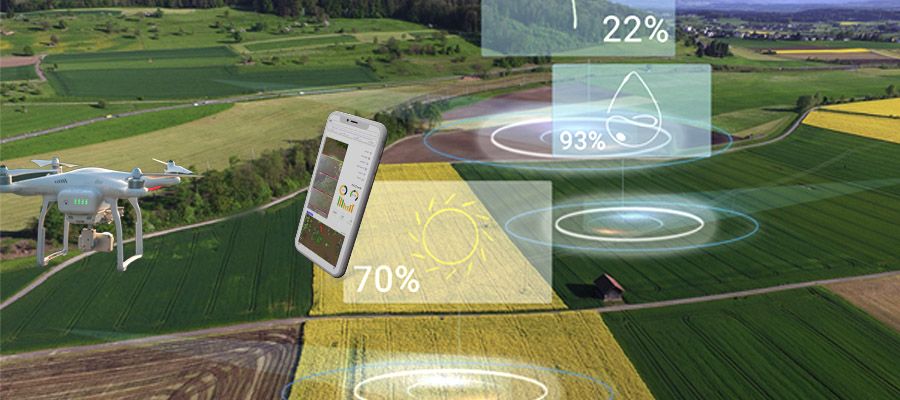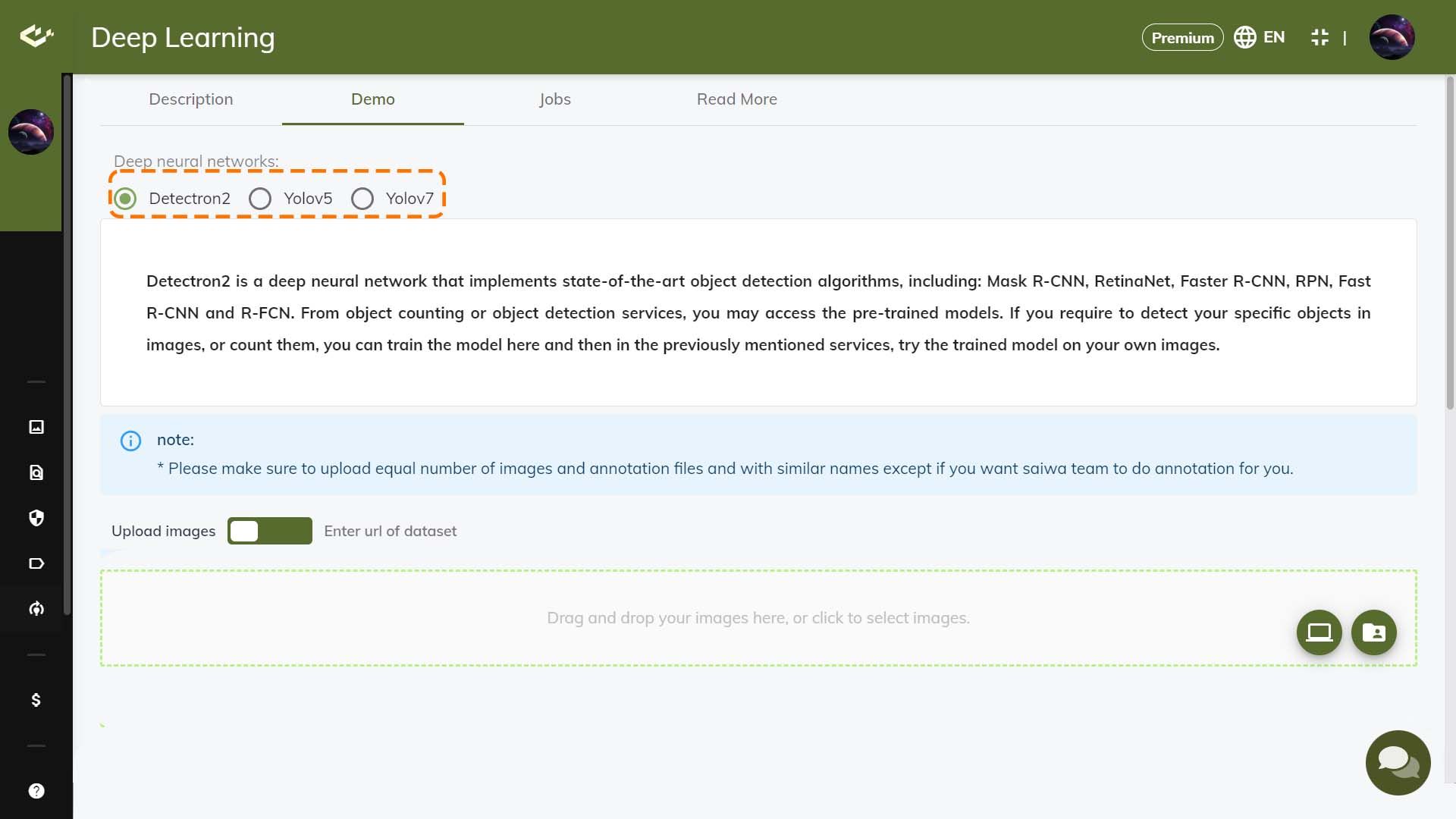
AI-Based Drone Operation| AI in Drones use cases
Artificial intelligence has the potential to transform the way people live and work. Artificial intelligence and drones are two technologies that have seen rapid advances in recent years. When these two technologies are combined, they create many applications that were previously impossible or ineffective. Artificial intelligence-based drones are designed to perform missions and tasks independently, learn from their environment, and adapt to changing conditions. This article examines the performance of AI in Drones and their uses in various industries.
An overview of drone technology
Before we discuss the role of artificial intelligence in drone technology and the application of artificial intelligence in drones, it is necessary to understand what drone technology entails. A drone is an unmanned aerial vehicle (UAV) that can be remotely controlled using pre-programmed instructions or operate autonomously. Drones come in many sizes and shapes, from small hand-held devices to large fixed-wing aircraft. They can be equipped with sensors, cameras, and other different technologies and perform certain tasks effectively.
Drone technology is widely used in various industries due to its many advantages. For example, it can be said that drones have significantly reduced the time and cost of data collection in various fields, including agriculture, construction, and other cases. They are also used in disaster management, search, and rescue missions, wildlife protection, and surveillance.
Read Also: AI and Natural Disaster Prediction
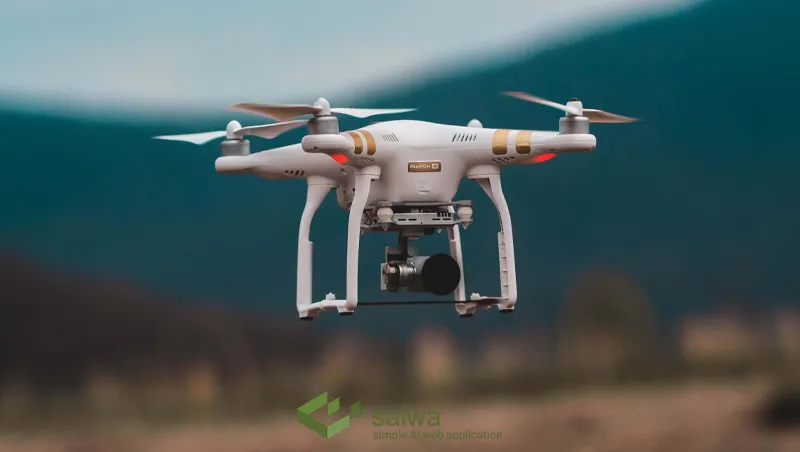
Introduction of artificial intelligence
AI stands for artificial intelligence. Artificial intelligence is the result of using cognitive science techniques to create something that performs tasks that only humans can perform, including reasoning, natural communication, and problem-solving. Artificial intelligence has many levels, from simple rule-based systems to complex learning machines.
Drones are one type of robot that is widely popular and practical. They are now used in various settings including law enforcement, search and rescue, and agriculture.
What is AI, and how does AI in Drones work?
Artificial intelligence is about using algorithms and data to give machines the ability to learn and make decisions. In the field of AI for drones, artificial intelligence can provide information and decision-making capabilities to the drone. For example, a drone equipped with artificial intelligence can analyze data from its sensors, including cameras, to identify objects and features on the ground, then it can use this information to make decisions about where to fly, how to avoid obstacles, and how to fly. Use it to complete your mission.
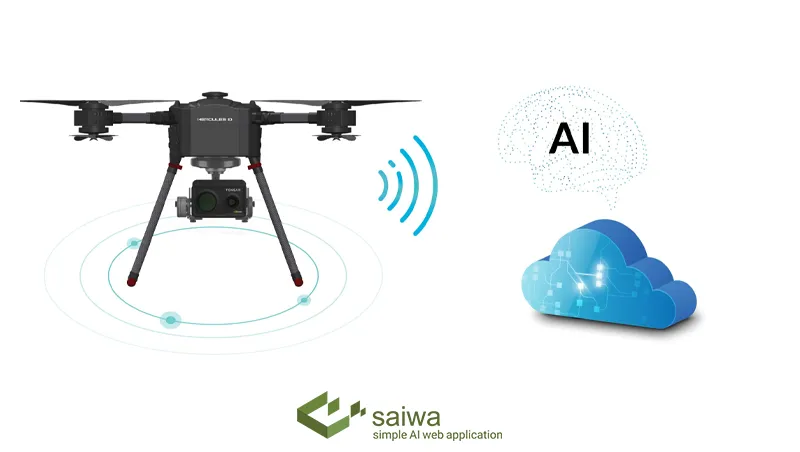
What is The Significance of AI in Drones?
Artificial intelligence-based drones have significant advantages compared to traditional drones. They can identify obstacles in real-time and avoid them, fly for longer periods, and perform tasks more accurately. This allows them to perform tasks that are otherwise impossible or inefficient for human operators or traditional drones. Among their applications in various industries, we can mention agriculture, security, and general and other cases.
AI in Drones Use Cases
In this section, we intend to fully address the common uses of drones based on artificial intelligence. If you want to know what these drones are used for, this part of the article can help you a lot:
Agriculture
AI-powered drones can scan large agricultural fields and collect data on crop health, irrigation, and soil moisture. Data collected by AI for drones can help farmers optimize crop yields, reduce water consumption, and detect pests and diseases early. Drones equipped with thermal imaging sensors can also detect and identify signs of heat, helping farmers find livestock that need attention and demonstrating the profound impact of AI in agriculture.
Partner advancements introduce weed detection models allowing targeted herbicide spraying exclusively on invasive outbreak locations minimizing unnecessary chemical use. Expert field scouting likewise becomes partially automated identifying pests for pesticide guidance and surveying individual stalk/crop quality to isolate underperforming zones reflecting soil variation. Aggregate farm crop insights direct complete downstream decisions around equipment rentals, fertilizer needs and harvest labor planning through continuous statistical forecasts.
Infrastructure Inspections and Maintenance
Regular structural inspections on expansive infrastructure from bridges to oil pipelines present monumental undertakings given limited vantage points for human appraisals trying to cover extremely vast areas consistently. Specialized AI drones fulfill this persistent monitoring need optimally leveraging automated computer vision scalably across mile-wide zones. Trained structural damage classifiers identify microscopic cracks in concrete crevices and corroded metal struts requiring maintenance hundreds of meters below suspended bridge sections that manned supervision could never repeatedly cover reliably.
Land based pipelines suffer similar oversight hurdles vulnerable to seam cracks and meat neighboring development encroachments threatening integrity. Drone fleets survey thousands of miles economically scanning entire lengthwise tracings near continuously aided by AI guidance. This preventative approach increases anomaly detection saving massive downline repair costs through early maintenance.
Construction
AI-powered drones can create 3D maps of construction sites and monitor progress over time. Drones can also inspect structures and identify defects or issues that may need attention. This saves time and resources compared to traditional manual inspections.
Energy
AI-powered drones can inspect power lines, wind turbines, and other energy infrastructure, reducing the need for manual inspections that can be costly and dangerous. Drones equipped with sensors can detect faults and problems and allow the repair process to be carried out before major failures occur.
Public safety
Artificial intelligence-based drones can be used by law enforcement and emergency responders to gather information and assess situations quickly. Drones can also be equipped with cameras and sensors to identify hazards, locate missing people, and monitor traffic flows.
Surveillance and Security Applications
Persistent wide-area monitoring represents one of the earliest viable applications for AI drone infrastructure originating from military reconnaissance needs. However subsequent advances enhanced computer vision functionality beyond mere target tracking into multifaceted detections like hazard identification, height measurement, and selective object classification. This awareness aptly transfers into commercial security use cases through automated perimeter breach alerts, suspicious activity reports, and pattern-of-life assessments on secured zones. AI camera feeds even interface with existing camera networks to enrich ground surveillance capabilities.
Law enforcement similarly benefits from aerial vantage points gathering crowd statistics and detecting traffic accidents to dynamically reorient patrol vehicle assignments using real-time data fusion. Suspicious bags, stolen goods or wanted suspects also prove trackable across districts through continuously trained object classifiers tailored to security entities’ priority items. Together this amplifies monitoring efficacy and situational responsiveness beyond what limited legacy camera infrastructure afforded.
Another important application of AI in drones for surveillance and security is facial recognition drone. These equip drones with a bird's-eye view and real-time identification capabilities. Imagine drones at concerts scanning crowds to identify missing people or security forces using them to pinpoint potential troublemakers. In addition, it can be used by Law enforcement to see them as valuable tools for investigations and suspect apprehension.
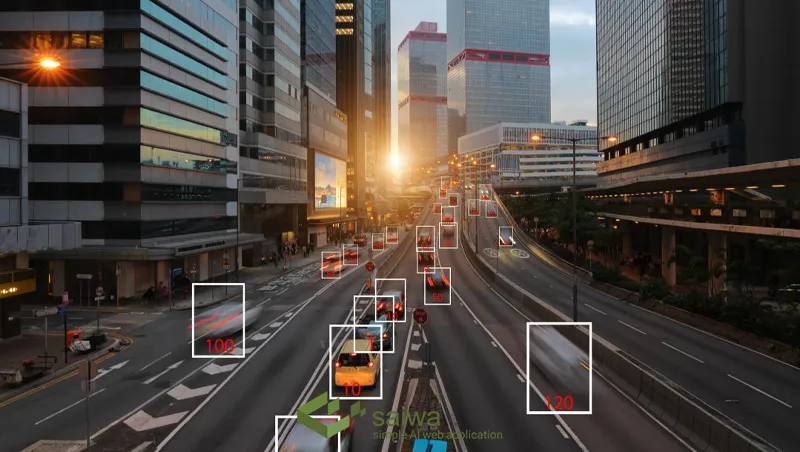
Development of AI algorithms for autonomous navigation
The creation of AI algorithms for autonomous navigation and obstacle avoidance is one of the application of artificial intelligence in drones and it is essential to the safe and efficient operation of unmanned vehicles, like drones, in dynamic situations. Artificial intelligence and sensor technologies are combined in autonomous navigation to provide real-time path planning and decision-making.
Sensor Fusion: Central to autonomous navigation is the integration of diverse sensors, including cameras, lidar, radar, and inertial measurement units (IMUs). Sensor fusion techniques combine data from these sources to provide a comprehensive understanding of the drone's surroundings. By leveraging the strengths of each sensor, the system gains robustness in detecting obstacles and determining the vehicle's position.
Simultaneous Localization and Mapping (SLAM): AI algorithms implement SLAM, a technique that allows the drone to build a map of its environment while simultaneously localizing itself within that map. This is particularly crucial in scenarios where pre-existing maps may be unavailable or incomplete. SLAM algorithms contribute to the creation of accurate and up-to-date maps that facilitate effective navigation.
Path Planning and Optimization: AI-driven path planning involves determining the optimal trajectory for the drone while avoiding obstacles. These algorithms consider factors such as energy efficiency and real-time adjustments for dynamic obstacles. Machine learning plays a role in training models to predict the best paths based on historical data and current sensor inputs.
Obstacle Detection and Recognition: Computer vision, often powered by deep learning models, is employed for real-time obstacle detection and recognition. Convolutional Neural Networks (CNNs) excel in identifying objects in the drone's path, allowing the system to make informed decisions about navigation adjustments.
Real-Time Decision-Making: AI algorithms enable drones to make split-second decisions based on incoming sensor data. Predictive modeling and dynamic obstacle avoidance strategies are employed to navigate through complex environments safely.
The development of AI algorithms for autonomous navigation and obstacle avoidance which is one of the application of artificial intelligence in drones, involves a combination of sensor integration, simultaneous localization and mapping, path planning, obstacle detection, and real-time decision-making. These technologies collectively empower drones to operate autonomously, opening up a myriad of applications from precision agriculture and delivery services to search-and-rescue missions. The ongoing refinement of these algorithms continues to advance the capabilities and safety of autonomous systems in navigating intricate and unpredictable surroundings.
Read Also: Satellite and Drone Imagery | A Comparative Analisys
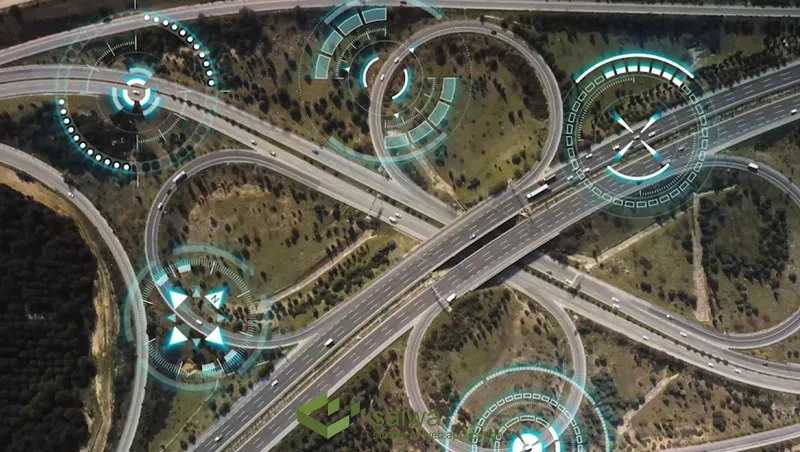
How do AI drones fly?
Drones are unmanned aircraft that fly using remote control or by following pre-planned flight paths. Some drones are equipped with cameras and can be used for photography or filming. Agricultural drone mapping can be equipped with sensors and used for mapping or monitoring crops and wildlife. Drones are widely equipped with artificial intelligence technology that gives them the ability to fly autonomously.
Using Artificial intelligence drones has various advantages. First of all, it should be said that the use of these drones does not require a human operator; this work can be costly and dangerous. Second, it enables drones to fly for longer periods and cover larger areas than would be possible with a human operator. Finally, artificial intelligence enables drones to make decisions on their own, for example, in the field of avoiding obstacles or identifying targets.
Artificial intelligence drones are used in various applications such as search and rescue, mapping, agriculture, and even delivery of goods. As this technology continues to develop, we will likely see a large number of drones flying autonomously in the sky.
Who makes the drones?
Drones have become widely popular and are now used for various purposes. Several companies make and sell drones, which are purchased for a variety of uses.
One of the most interesting applications of these drones is automation. With the help of artificial intelligence, drones can be programmed to fly autonomously and perform various tasks. This issue creates new opportunities for using drones in the future. For example, drones can be sent to deliver various packages. These drones use artificial intelligence to navigate to the desired address for safe delivery of the package. This saves time and can help reduce traffic.
Other examples include drones used in code security. These drones, which are equipped with artificial intelligence, can patrol an area and seek to identify suspicious activities. If they detect something, they can activate the alarm and alert the necessary authorities.
When it comes to artificial intelligence drones, the possibilities are endless. This is an exciting development that will change the future.
Role of Reinforcement Learning in Drone Autonomy
Reinforcement learning (RL) is an area of machine learning that has gained significant attention in the context of autonomous systems, including drones. RL algorithms enable drones to learn by interacting with their environment and receiving rewards or penalties based on their actions. This approach allows drones to develop optimal behaviors and strategies without the need for extensive pre-programming or explicit supervision.
One of the key advantages of reinforcement learning for artificial intelligence in drone autonomy is its ability to handle complex, dynamic environments. Traditional rule-based systems or supervised learning approaches can struggle with the unpredictability and variability of real-world scenarios, whereas RL algorithms can adapt and learn through trial-and-error interactions.
In the context of drones, reinforcement learning can be applied to various tasks, such as navigation and path planning, obstacle avoidance, target tracking, and payload delivery. RL agents can learn to navigate through cluttered environments, avoiding obstacles while optimizing their trajectories for efficiency and energy conservation. They can also learn to track and follow moving targets, adjusting their flight patterns in real-time based on the target's behavior.
AI Drones Fleet Management
As the use of AI drones becomes more widespread, effective fleet management becomes crucial for ensuring efficient operations, resource optimization, and cost-effectiveness. AI techniques are being applied to various aspects of drone fleet management, from route optimization and scheduling to predictive maintenance and fault detection.
Route optimization algorithms leverage AI drones and machine learning to plan the most efficient flight paths for a fleet of drones, taking into account factors such as battery life, payload capacity, and mission objectives. These algorithms can dynamically adjust routes in response to changing conditions, such as weather patterns or airspace restrictions, ensuring the timely and efficient completion of tasks.
Predictive maintenance and fault detection are essential for minimizing downtime and reducing operational costs. By analyzing sensor data and flight telemetry, AI drones models can identify patterns and anomalies that may indicate potential issues or component failures. This allows for proactive maintenance and repair, reducing the likelihood of unexpected breakdowns and increasing the overall reliability of the drone fleet.
Resource allocation and task assignment are critical components of effective fleet management. AI drones algorithms can optimize the assignment to specific tasks based on their capabilities, payload capacities, and locations. This ensures that the most suitable drones are assigned to each mission, improving overall efficiency and reducing redundancy.
Cybersecurity Challenges and Solutions for AI Drones
While AI Drones offer numerous benefits and applications, they also introduce new cybersecurity challenges that must be addressed to ensure secure and reliable operations. As AI Drones become more autonomous and connected, they become potential targets for cyber threats, such as hacking, data breaches, and malicious interference.
One of the primary cybersecurity challenges for AI Drones is the protection of data transmission and communication channels. Secure encryption and authentication mechanisms are essential to prevent unauthorized access, data interception, or spoofing attacks. Advanced encryption algorithms and secure communication protocols must be implemented to safeguard the integrity and confidentiality of data exchanged between AI Drones, ground stations, and other connected systems.
Another critical aspect is the security of the AI algorithms and models used in AI Drones. Adversarial attacks and model evasion techniques can potentially compromise the decision-making capabilities of AI Drones, leading to unexpected or malicious behavior. Robust model validation, testing, and continuous monitoring are necessary to detect and mitigate such threats.
Physical security and access control measures are also crucial for AI Drones. Unauthorized physical access to the drones or their infrastructure can lead to tampering, data theft, or the introduction of malicious hardware or software components. Implementing secure access controls, tamper-evident seals, and physical security measures can help mitigate these risks.
Ethical Considerations and Governance for AI-Powered Drones
As artificial intelligence in drones become more prevalent and capable, it is crucial to address the ethical considerations and governance frameworks surrounding their development and deployment. These technologies raise important questions about privacy, security, accountability, and the potential for misuse or unintended consequences.
Privacy and Surveillance Concerns
AI-powered drones equipped with advanced sensors and object detection capabilities can potentially capture sensitive personal data, including images, video, and audio recordings. This raises concerns about privacy violations, particularly in public spaces or residential areas. Clear guidelines and regulations are needed to protect individual privacy rights while allowing legitimate uses of drone technology.
Dual-Use and Potential Misuse
Like many technologies, artificial intelligence in drones can be used for both beneficial and harmful purposes. While they have numerous applications in areas like search and rescue, infrastructure inspection, and environmental monitoring, they could also be misused for illegal surveillance, targeted attacks, or other malicious activities. Robust governance frameworks and export controls are necessary to prevent the proliferation and misuse of these technologies.
Accountability and Liability
As AI based drone application systems become more autonomous and complex, questions arise about accountability and liability in cases of accidents, incidents, or unintended consequences. Establishing clear legal and ethical frameworks for assigning responsibility and ensuring transparency in AI-powered drone operations is crucial.
Algorithmic Bias and Fairness
Like other AI based drone application systems, the algorithms and models used in AI-powered drones can exhibit biases or unfair decisions due to biased training data or flawed algorithms. Efforts must be made to ensure fairness, non-discrimination, and ethical decision-making in the development and deployment of these technologies.
Environmental Impact
The widespread adoption of AI-powered drones may have implications for the environment, including noise pollution, disruption of wildlife habitats, and potential contributions to climate change through energy consumption and emissions. Assessing and mitigating these environmental impacts should be part of the ethical considerations.
Drone AI Fleet Management and Logistics
As the adoption of drone AI tech grows, managing and coordinating large fleets of drones becomes a critical challenge. AI plays a crucial role in optimizing drone fleet management and logistics, ensuring efficient operations, resource allocation, and cost-effectiveness.
AI algorithms can be employed for route planning and optimization, taking into account factors such as battery life, payload capacity, weather conditions, and airspace regulations. These algorithms can dynamically adjust flight paths and schedules based on real-time data, ensuring timely and efficient mission completion.
Predictive maintenance is another area where AI can significantly contribute to drone fleet management. By analyzing sensor data, flight telemetry, and historical records, drone AI models can predict potential failures or maintenance requirements, enabling proactive measures to be taken. This predictive approach reduces downtime, minimizes operational disruptions, and extends the lifespan of drone AI.
AI-driven resource allocation and task assignment are also essential for optimizing drone fleet operations. Drone AI algorithms can match specific drones with suitable tasks based on their capabilities, payload capacities, and locations, ensuring the most effective utilization of resources and minimizing redundancies.
Key challenges of AI in Drones
The following are some of the key challenges associated with widespread adoption of AI-based drones:
Regulations and privacy concerns
Drones equipped with artificial intelligence technology can record and process large amounts of data, including personal information. As a result, there are various regulations and privacy concerns regarding the use of artificial hash-based drones, especially in public spaces. Most countries have established strict regulations for the use of drones, and various businesses must comply with these rules and regulations to avoid legal penalties.
Technical challenges
Artificial intelligence-based drones require complex hardware and software to function effectively. These drones must be equipped with powerful processors and sensors to process and analyze data in real-time. They also need sophisticated algorithms and machine learning models to make more accurate decisions.
Data management
AI-based drones generate large amounts of data, and businesses need to make sure they have the necessary infrastructure to manage and store this data. This can be a significant challenge, especially for businesses with limited IT resources or those who work in remote locations.
Cost
Developing, deploying, and maintaining AI-based drones can be expensive. The technology required to enable real-time data processing and analysis, as well as machine learning models and algorithms, can be costly. Also, businesses should invest in high-quality drones and ensure the necessary expertise to operate and maintain them effectively.
Skill gap
To effectively develop and operate AI-powered drones, businesses need access to skilled data scientists, engineers, and drone operators. However, there is a significant skills gap in this area, and most businesses struggle to find the talent they need.
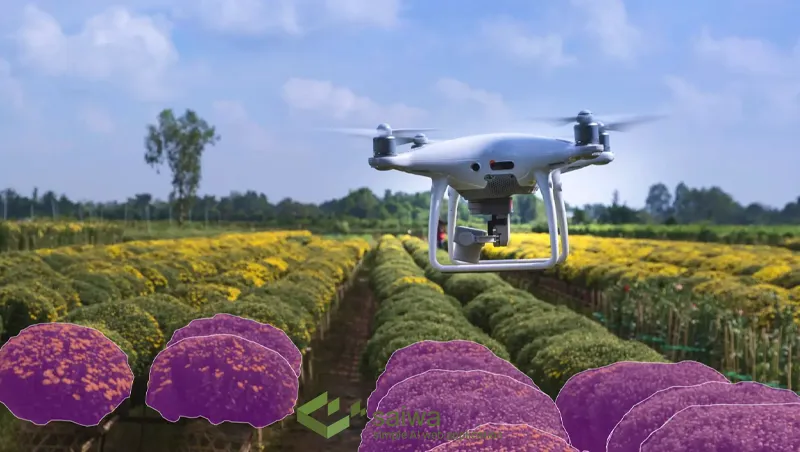
How to overcome the above challenges?
In this section, we have stated some solutions to overcome the aforementioned challenges in the widespread adoption of drones based on artificial intelligence:
Training: The lack of skilled operators and technicians is a very important challenge for the widespread adoption of artificial intelligence-based drones. Training programs and certification courses should be provided to provide individuals with the necessary skills to use and maintain AI-based unmanned aerial vehicle (UAV)
Improved regulations: Regulations regarding the operation of drones vary greatly between countries and, in some cases, are inadequate or not enforced. Governments and regulatory bodies should establish clear guidelines and regulations for the operation of artificial intelligence-based drones to ensure public safety and prevent various abuses.
Integration with existing systems: Integrating AI-based drone technology with existing systems, such as air traffic control and weather monitoring systems, can be a complex process. A concerted effort is needed to make sure these systems work seamlessly together.
Data security: The collection and transmission of data from artificial intelligence-based drones must be secure to prevent unauthorized access and data corruption. To protect sensitive information collected by drones, advanced encryption techniques, and secure data storage solutions must be implemented.
Cost-effective solutions: The cost of drone technology based on artificial intelligence is high and can be an important barrier to its widespread adoption. To overcome this existing challenge, manufacturers must develop cost-effective solutions that can be easily integrated into existing systems.
Battery improvement technology: Battery life is a very important challenge for AI-based drones, especially for long-range operations. The development of advanced battery technology that can provide longer flight times and faster charging is essential for the widespread adoption of AI-based drones.
Improved artificial intelligence algorithms: The effectiveness of drone technology based on artificial intelligence is related to the accuracy and efficiency of its algorithms. Continued research and development of advanced algorithms that can analyze data quickly and accurately is essential for the successful integration of AI-based drones in various industries.
Considering these challenges and trying to solve them, the widespread adoption of artificial intelligence-based drones can happen faster and increase efficiency, productivity, and safety in various industries.
How to get the power of drones based on artificial intelligence?
If you are looking to benefit from artificial intelligence-based drones in your business activities, here are the steps you can take:
Identify the use cases
Research and determine how AI-powered drones can be used in your industry or business. Look for use cases that can improve productivity, reduce costs, or enhance the customer experience.
Choose the right drone
Choose a drone that is specifically designed for your use. Look for drones that are reliable, easy to operate, and equipped with the necessary sensors and cameras for this task.
Find the right AI software
Choose AI software that can perform the tasks you need to automate. Look for software that easily integrates with your drone and offers features such as object detection, route planning, and obstacle avoidance.
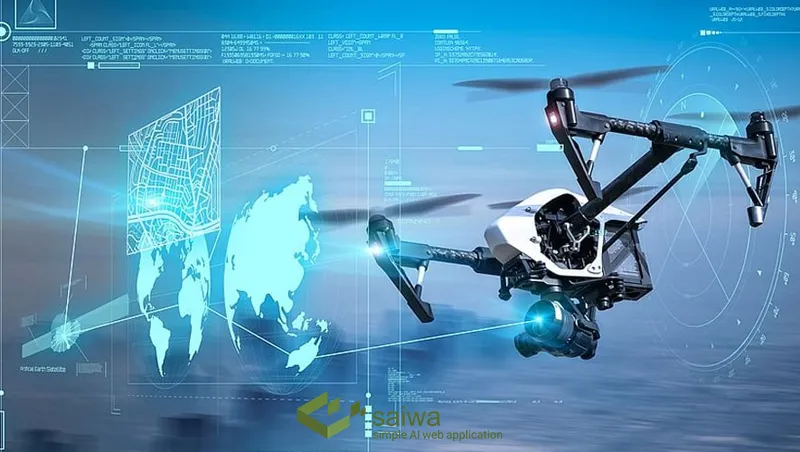
Artificial intelligence training
Train artificial intelligence software to recognize objects and environments related to your use cases. This helps ensure that the drone can operate independently and perform its tasks accurately.
Establish standard operating procedures
Establish a set of standard operating procedures for using AI-powered drones in your business. This includes safety protocols, maintenance procedures, and emergency response plans.
Performance Monitoring
Constantly and regularly review the performance of your AI-powered drones to identify areas for improvement. Analyze the data collected by the drone and use it to optimize operations, reduce costs, and improve efficiency.
By following these steps, businesses can use the power of AI-based drones to gain competitive advantage, improve productivity, and enhance customer experience.
Automating drones using artificial intelligence techniques
Using artificial intelligence techniques including machine learning drones and computer vision, developers are teaching drones to think for themselves. With this, they hope that the drones will be more intelligent and able to perform tasks such as obstacle avoidance and target tracking without human intervention.
One of the challenges in the automation of drones is that they must operate in unstructured environments. That is, they must be able to adapt to their surroundings during flight and make decisions based on incomplete or changing information.
Machine learning drones are a promising approach for teaching drones how to do this. Using machine learning drones, developers can train drones to recognize objects and interpret their surroundings. This allows them to make decisions based on what they see and not have to follow predefined rules set by humans.
Computer vision is another key technology to make drones smarter. By equipping aircraft with cameras and algorithms that can interpret what they see, drones can learn to navigate their environment and avoid obstacles. This is especially important for flying drones indoors, where there are many potential hazards to avoid.
The combination of artificial intelligence techniques, including machine learning drones and computer vision, gives developers the ability to build drones that are much smarter and more autonomous than anything that exists today.
This will open up:
Collecting flight data from unmanned pilots
Supervised learning algorithm
Drones are equipped with a set of sensors that can collect a large amount of data. This data can be used to train a supervised learning algorithm for the autonomous flight of drones.
One of the advantages of artificial intelligence for flying drones is that it can help avoid obstacles. Drones equipped with artificial intelligence can use their sensors to identify obstacles and avoid them. This is important for safety and can help prevent accidents.
Another advantage of using artificial intelligence to fly drones is that it can help improve flight efficiency. Drones equipped with artificial intelligence can plan their routes more effectively and avoid wasting time. This can save time and money.
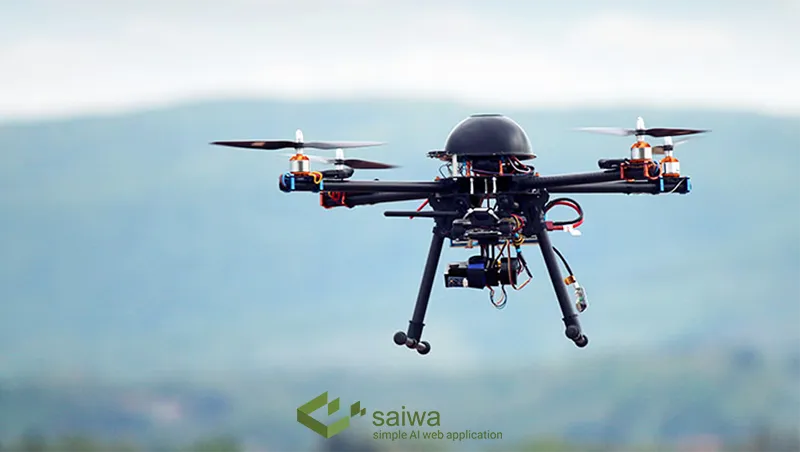
AI-Powered Drones in Military Defense
The next-generation unmanned aerial vehicles (UAVs) are revolutionizing military defense by leveraging the power of artificial intelligence (AI). Imagine a tireless sentry patrolling vast stretches of border, its AI brain analyzing real-time data to identify potential threats with superhuman accuracy. These AI drones are more than just scouts; they're becoming invaluable assets for modern militaries.
AI equips these drones with exceptional capabilities. Their advanced processing power allows them to analyze vast amounts of data collected by high-resolution cameras and other sensors, enabling them to detect and track targets with unmatched precision. This real-time intelligence gathering helps commanders to make faster, more informed decisions, keeping troops safer and missions more efficient.
But AI drones aren't just about intel. Imagine a group of these intelligent machines working together seamlessly, providing real-time situational awareness and coordinated support during critical missions. AI drones can act as force multipliers, assisting troops in search and rescue operations, providing crucial cover during evacuations, or even helping to disarm explosive devices.
The responsible use of AI drones in military defense holds immense potential. These intelligent machines can significantly enhance a nation's ability to protect its borders, safeguard its people, and ensure the success of critical operations. As AI technology continues to evolve, AI drones will undoubtedly become even more sophisticated, offering even greater advantages for military defense in the years to come.
Explainable AI for Drones: Demystifying Decisions Made by Autonomous Systems
AI for drones has revolutionized how these unmanned aerial vehicles operate. Drones can now fly autonomously, performing complex tasks like obstacle avoidance, object recognition, and navigation. But with this growing autonomy comes a critical question: how do we understand the decision-making process behind an AI-powered drone's actions? This is where Explainable AI (XAI) for drones comes in. XAI helps us decode the "black box" of AI algorithms used in drones. By providing transparency into how AI for drones arrives at its decisions, XAI fosters trust and ensures responsible operation.
Imagine a scenario where an AI-powered drone tasked with crop monitoring identifies a potential disease outbreak. XAI can explain the visual cues and data points that led the AI to this conclusion. This empowers farmers to verify the AI's findings and make informed decisions about treatment strategies.
Explainable AI for drones is particularly important in safety-critical applications. In search and rescue missions, for example, understanding why an AI for drones identifies a particular location as a potential survivor site can be crucial for guiding rescue teams. There are several techniques used in Explainable AI for drones. Feature attribution methods pinpoint the specific data points that most influenced the AI's decision. Visualization tools can create human-readable explanations of complex AI models.
By incorporating XAI principles into the development and deployment of AI for drones, we can ensure that these autonomous systems operate transparently, ethically, and responsibly. This will pave the way for even wider adoption of AI-powered drones across various industries.
The future of advanced drones with artificial intelligence
As artificial intelligence continues to evolve, the future of drone technology is even more promising and the application of artificial intelligence in drones is increasing. Advanced artificial intelligence algorithms give drones the ability to cooperate and communicate with each other, paving the way for a large number of unmanned drones to perform complex missions effectively.
In addition, AI-equipped drones are integrated into smart city frameworks, creating interconnected ecosystems that use data collected by drones to optimize urban planning, traffic management, and Environmental protection efforts.
Artificial intelligence has revolutionized drone technology, created new possibilities, and changed industries. Currently, drones are becoming essential tools in agriculture, construction, public security, and beyond. As artificial intelligence technology and drones go hand in hand, we can expect even greater advancements in the future that will redefine the way we interact with the world.
The role of deep learning in improving drone annotation accuracy
The role of deep learning in improving drone annotation accuracy is pivotal, ushering in a new era of enhanced capabilities and precision in aerial applications. Object detection, a fundamental task in computer vision, involves identifying and localizing specific objects within an image or video frame. Drones, equipped with cameras and sensors, generate vast amounts of visual data that necessitate efficient and accurate processing, making deep learning a natural fit for this domain.
Deep learning techniques, particularly convolutional neural networks (CNNs), have revolutionized drone annotation by automating feature extraction and learning intricate patterns within images. Unlike traditional methods that heavily rely on handcrafted features and rule-based algorithms, deep learning models can automatically learn hierarchical representations from raw data, adapting to diverse and complex visual scenarios encountered in drone imagery.
One of the key advantages of deep learning in drone annotation is the ability to handle variations in scale, orientation, and lighting conditions. Drones operate in dynamic environments where objects of interest may appear at different sizes and angles. Deep learning models excel at capturing these variations, ensuring robust performance across a wide range of scenarios.
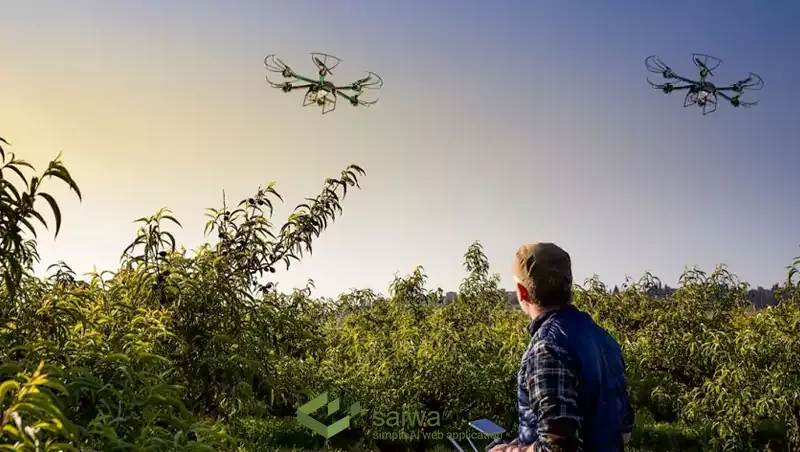
Moreover, the use of deep neural networks allows for the development of sophisticated architectures. These architectures enable real-time object detection, a crucial requirement for applications like surveillance, search and rescue, and infrastructure inspection.
Transfer learning is another notable aspect of deep learning that contributes significantly to improving drone annotation accuracy. Pre-trained models on large datasets can be fine-tuned with smaller, domain-specific datasets generated from drone imagery. This approach leverages the knowledge gained from diverse data sources, resulting in more effective and accurate object detection models for specific drone applications.
Drone annotation is revolutionized by deep learning, which lays the foundation for improved precision, flexibility, and real-time processing power. The combination of deep learning and drone applications is expected to propel technological progress in several areas, such as public safety, environmental monitoring, and agriculture.
Implementation of algorithms to detect objects in drone image AI
Implementing a set of algorithms to recognize objects in drone image AI is one of the most important parts of computer vision programs that help automation and efficiency in a wide range of industries, including agriculture, monitoring, and infrastructure inspection. Object detection includes identifying the presence and location of several objects in an image, and this feature assigns a tag or category to each detected object.
In the field of drone image AI, this work faces challenges due to various factors such as different lighting conditions, documentation, and the need for real-time processing. Convolutional neural networks have proven to effectively overcome these challenges. The region-based CNNs (R-CNN), You Only Look Once (YOLO), and Single Shot Multibox Detector (SSD) are popular architectures for object detection in drone images.
These algorithms divide the input image into a grid and predict bounding boxes and class probabilities for each grid cell. For example, YOLO enables object recognition in real time by simultaneously predicting bounding boxes and class probabilities.
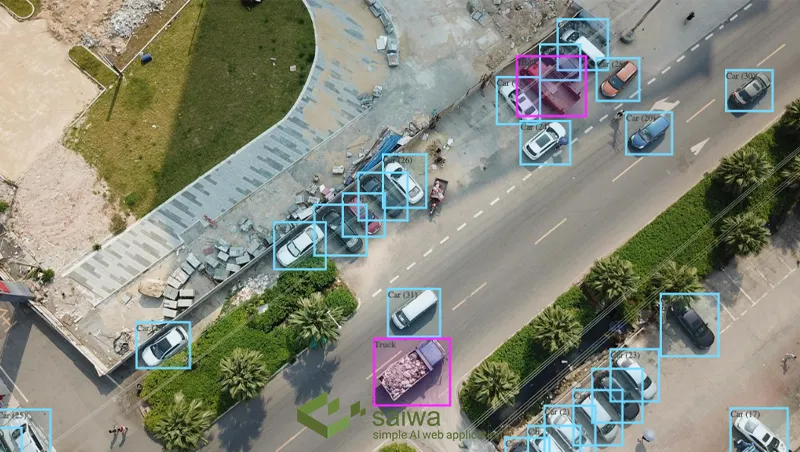
Transfer learning is another important part of implementing object detection algorithms for drone image AI. Models pre-trained on large datasets can be fine-tuned on smaller, domain-specific datasets associated with drone imagery. This helps to enhance the knowledge gained from general object detection tasks and adapt it to the nuances of scenes captured by drones.
Also, data augmentation techniques such as rotation, scaling, and flipping are usually used to increase the robustness of the model by placing it across a wide range of scenarios. This work is especially important in the applications of AI for drones, which can change the appearance of objects.
Implementation of algorithms for object detection in drone images including the establishment of complex neural network architectures, the use of transfer learning to use pre-trained models, and the combination of data augmentation techniques to increase model compatibility with the complexities of scenes captured by It is drones. This work helps a lot to develop accurate, efficient, and strong systems for automatic analysis of UAV images in different fields.
AI Drone Software
AI drone software equips drones with advanced capabilities, enabling them to perform tasks autonomously, make intelligent decisions, and operate with greater efficiency. This software unlocks a new level of potential for drones across various applications.
Saiwa.ai
Saiwa, a leader in AI solutions, offers Sairon, a tool designed to harness the power of AI for drone applications. Sairone automates the processing of high-resolution aerial images, and other precision-driven tasks. By compiling drone imagery into comprehensive, customer-requested reports, This AI drone software accelerates knowledge synthesis, eliminating the complexities of managing large data sets. This allows users to make informed decisions quickly and effectively.
Whether it's monitoring crop health, surveying landscapes, or assessing environmental impacts, Sairone's AI-powered drone applications offer unparalleled accuracy and efficiency.
Qii.ai
Qii.ai focuses on automating inspections, using AI to detect and classify defects in infrastructure, such as cracks in bridges or corrosion in pipelines. This streamlines the inspection process, saving time and resources for companies that rely on regular infrastructure checks.
DedroneTracker.ai
DedroneTracker.ai, on the other hand, takes a security-focused approach. It utilizes AI for drone detection and identification, helping to protect airspace from unauthorized drones. This is particularly crucial for sensitive areas like airports, government buildings, and critical infrastructure.
These are just a few examples of the diverse functionalities offered by AI drone software. With ongoing advancements in AI, we can expect even more sophisticated software solutions to emerge. The future holds immense potential for AI-powered drones, transforming how we utilize this technology across various sectors.
Overview of machine learning applications in drone technology
The capabilities of unmanned aerial vehicles have been transformed by machine learning applications in artificial intelligence drones, bringing in a new era of efficiency and adaptability. Drones are now able to process and analyze data in real time, which increases their intelligence and environment responsiveness thanks to the incorporation of machine learning algorithms.
Machine learning is a key component in artificial intelligence drones that improves navigation and decision-making. Drones may learn to identify trends, adjust to changing situations, and optimize their paths by being continuously exposed to a variety of data sets. This machine learning feature is especially important in situations when the drone's trajectory may be affected by dynamic environmental factors, such as in cities or during erratic weather.
Tracking and detecting objects is a noteworthy use of machine learning in artificial intelligence drones. Drones using cameras and other sensors can recognize and track particular items or people using machine learning algorithms. This feature is very helpful for monitoring wildlife populations as well as for surveillance and search and rescue missions. "Artificial intelligence drones" is a term that perfectly describes these learning-enabled, intelligent drones that can react to their environment in real-time.
Furthermore, machine learning facilitates the creation of predictive models within artificial intelligence drones. By analyzing historical data, drones can anticipate future trends, potential obstacles, or areas requiring attention. This predictive capability enhances the efficiency of tasks such as agricultural monitoring, where drones can assess crop health and predict potential issues before they become critical.
In the context of swarm intelligence, where multiple drones collaborate to achieve a common goal, machine learning algorithms enable seamless coordination. Each drone in a swarm can adapt its behavior based on the collective knowledge acquired by the group, creating a dynamic and adaptive network. This interconnected intelligence, inherent in artificial intelligence drones, allows them to tackle complex tasks collaboratively.
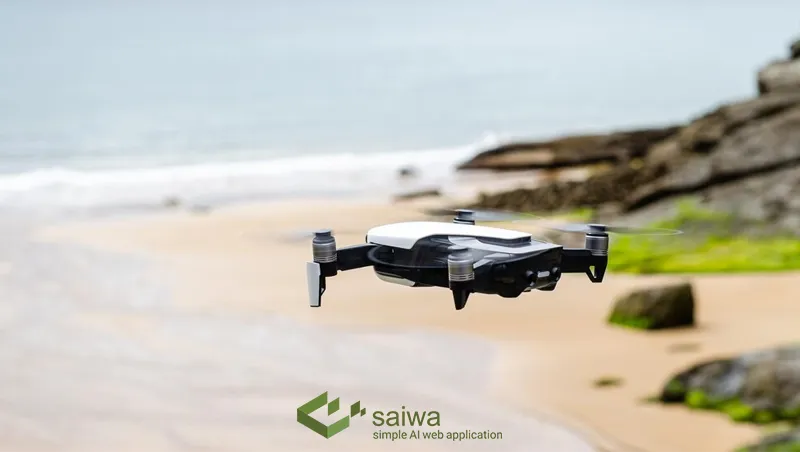
The possibilities in robotic aerial technology were broadened by the integration of artificial intelligence and machine learning in drones. "Artificial intelligence drones" applies to the merging of artificial intelligence algorithms with drones that are unmanned, resulting in a novel approach to problem-solving, exploration, and surveillance. These drones' capabilities will grow along with machine learning, making them essential tools for a variety of businesses.
Conclusion
AI in drones is transforming various industries with its capabilities in remote monitoring, precision agriculture, disaster response, and more. Of course, these technologies face challenges such as regulatory issues, serious security hubs, and privacy concerns, but these challenges can be overcome with careful planning and technological innovation. By following the practical steps we've outlined, businesses can use artificial intelligence-based drones to improve performance, increase efficiency, and ultimately achieve their goals. With the continued development and adoption of these technologies, the future possibilities for AI-powered drones are limitless.
